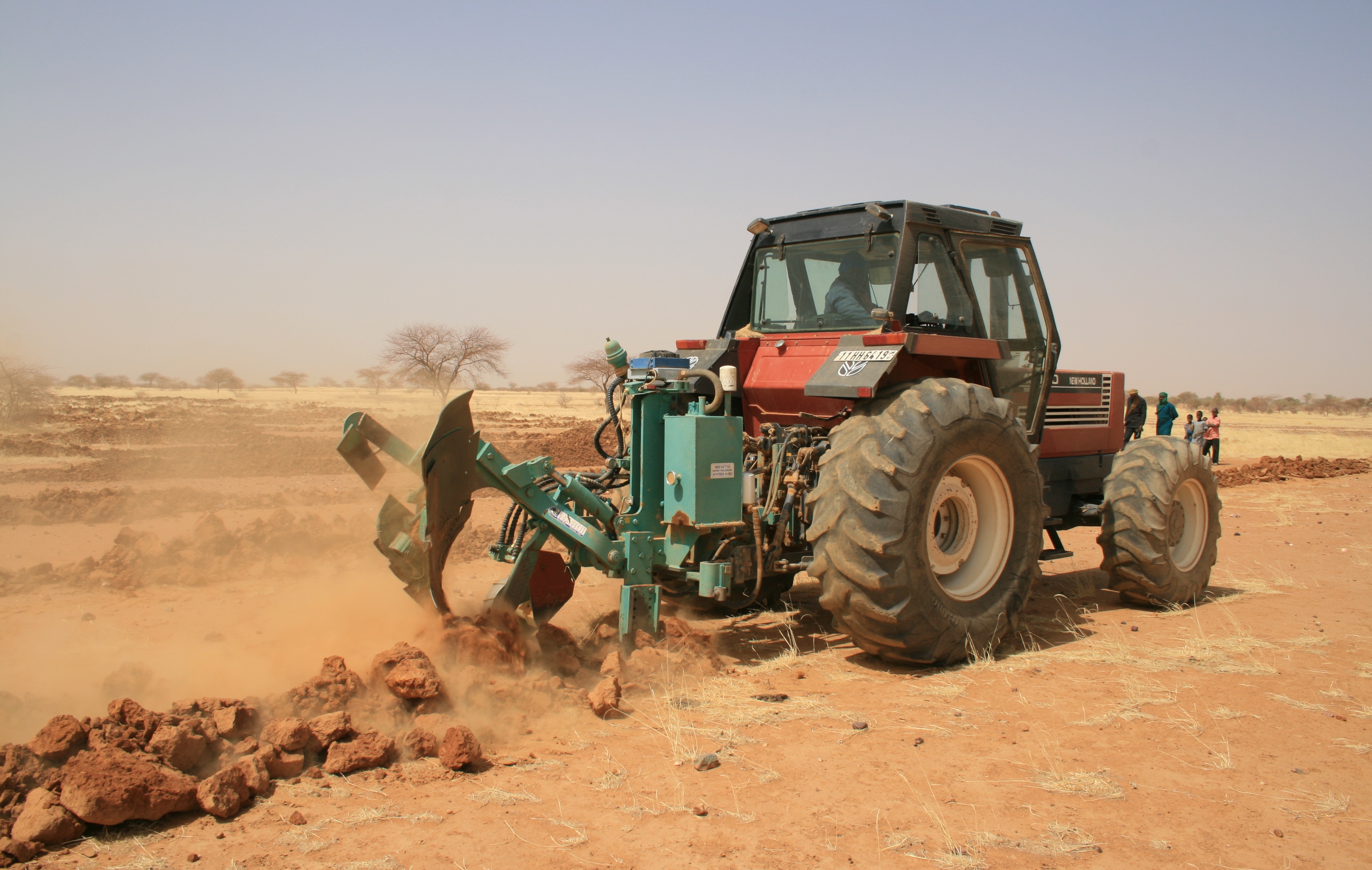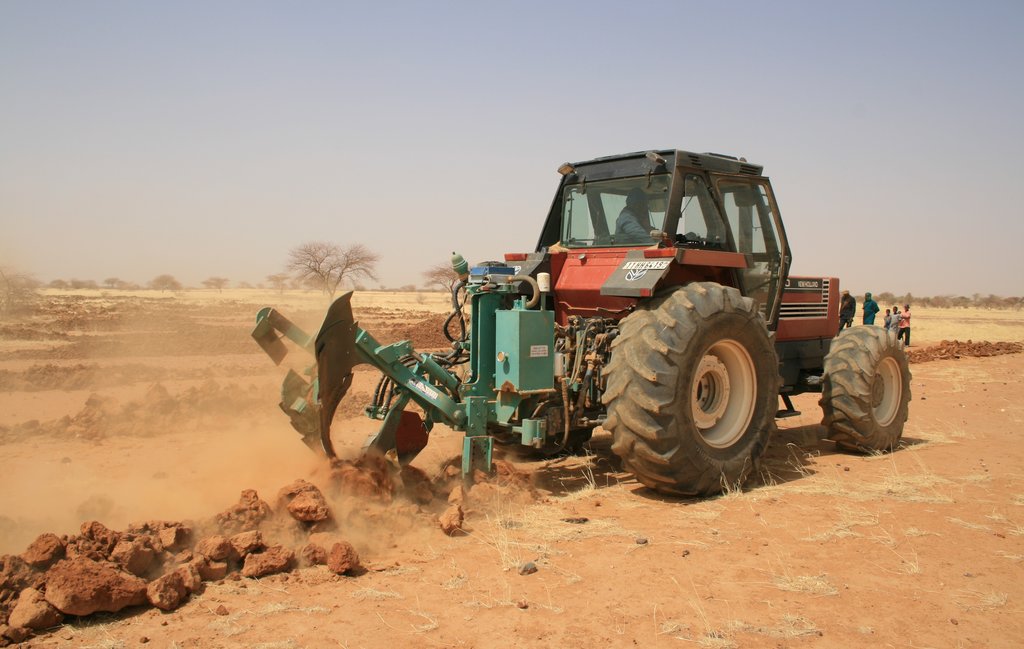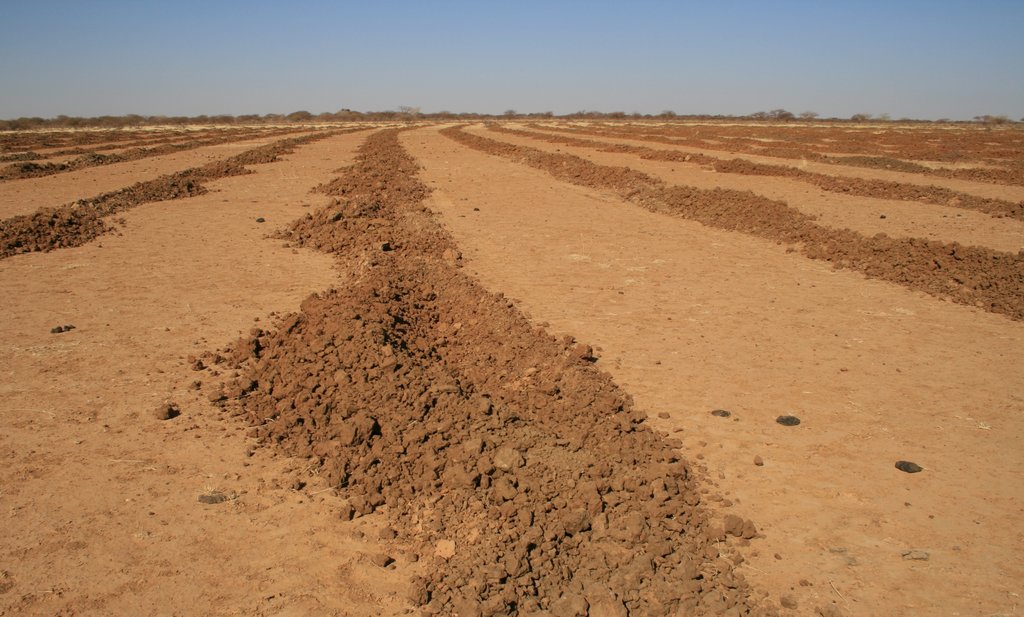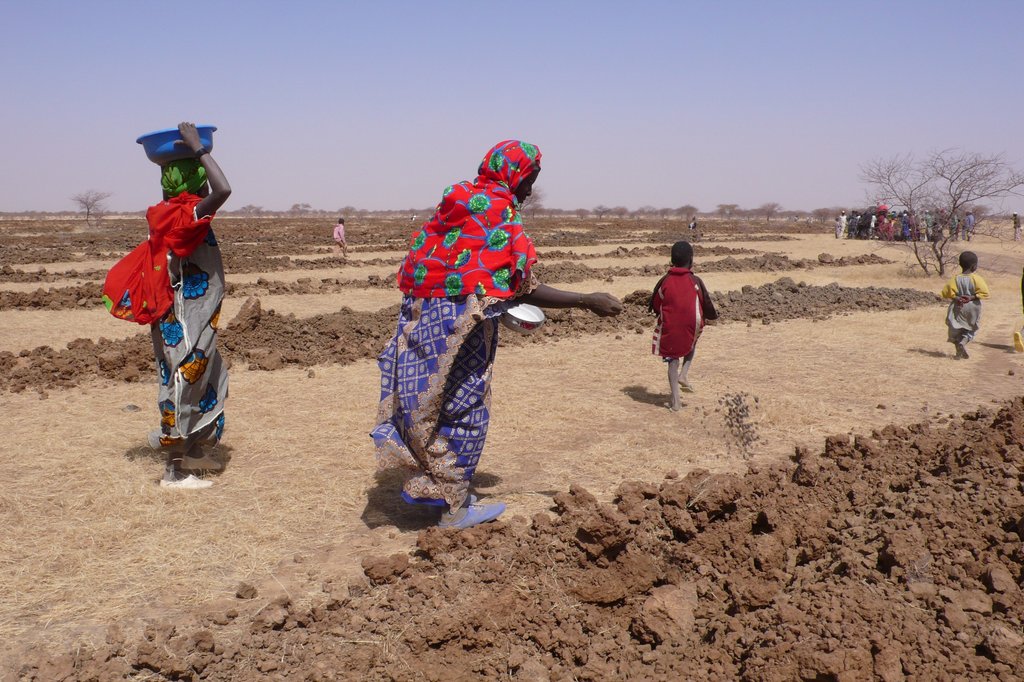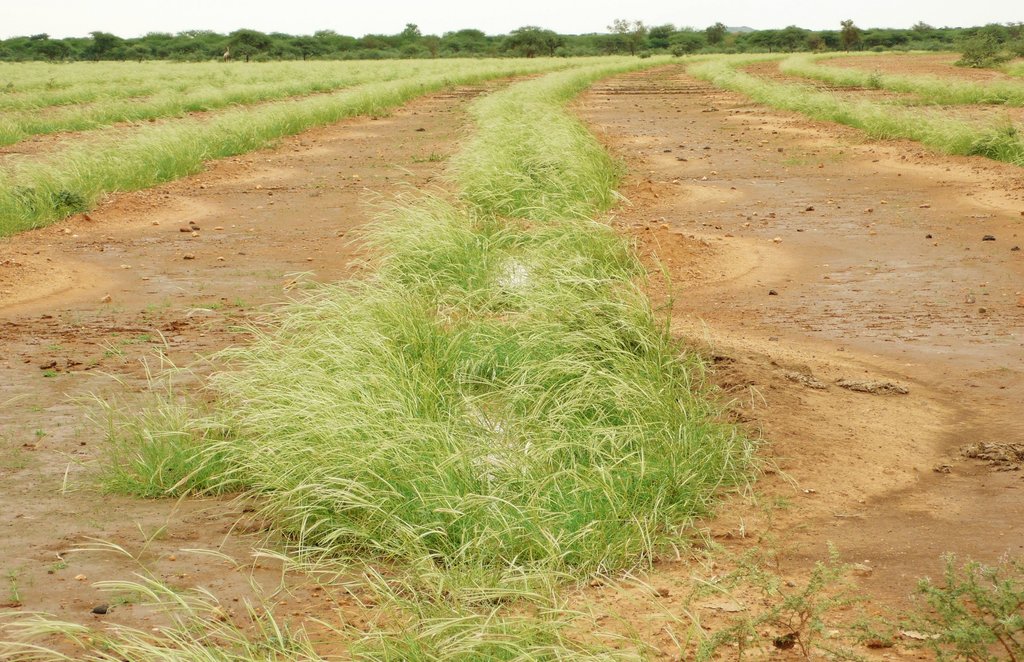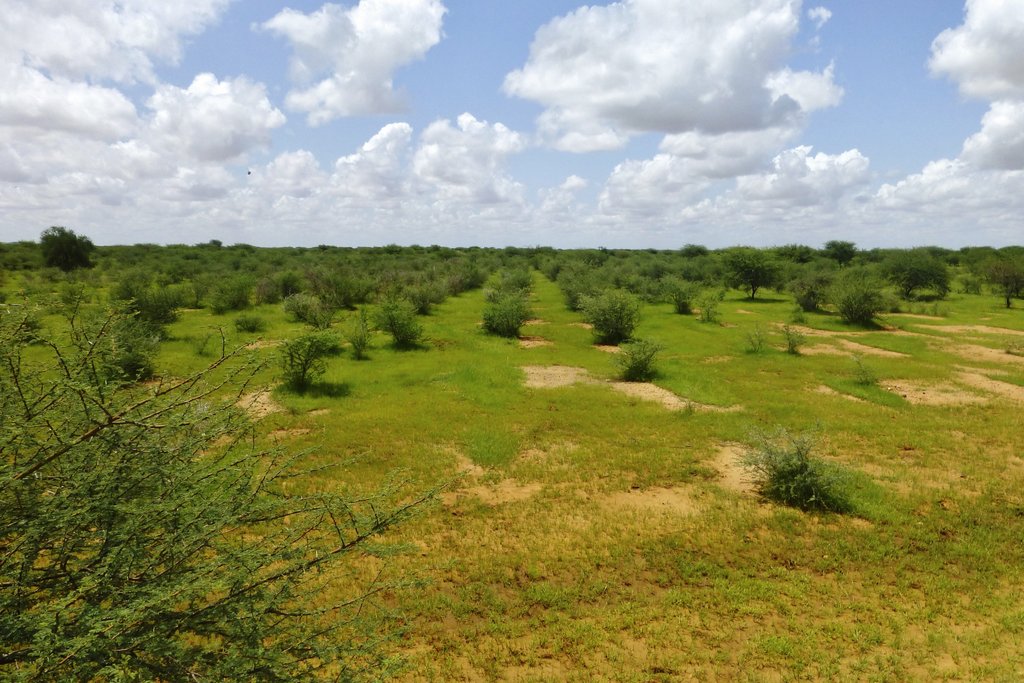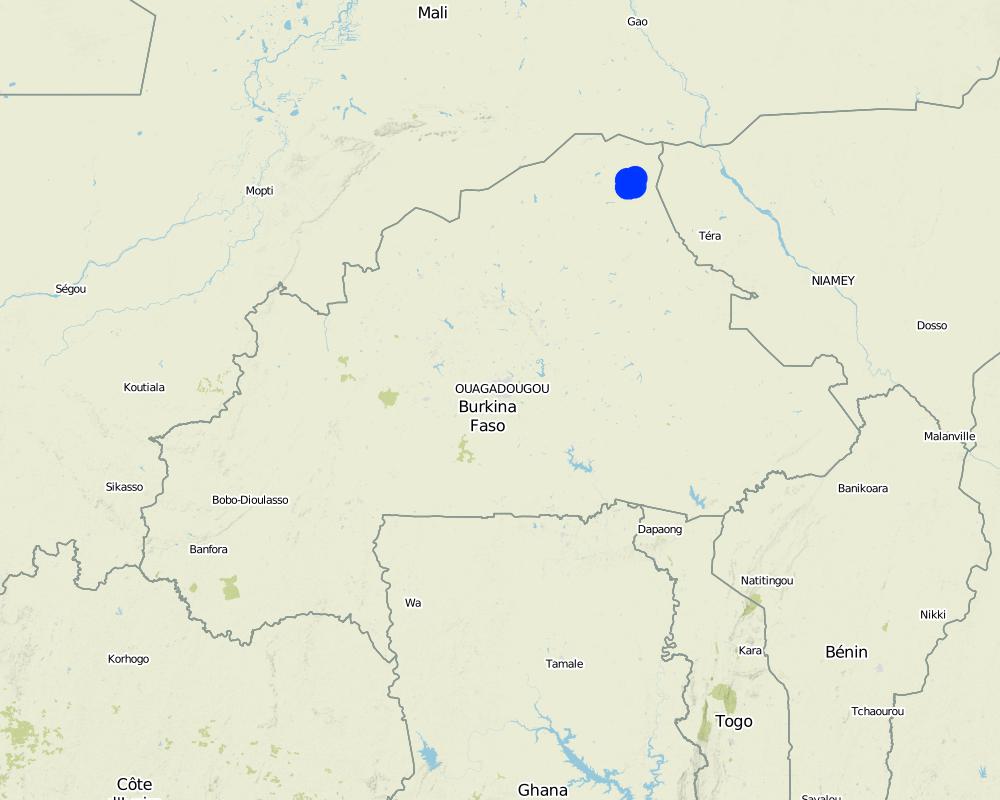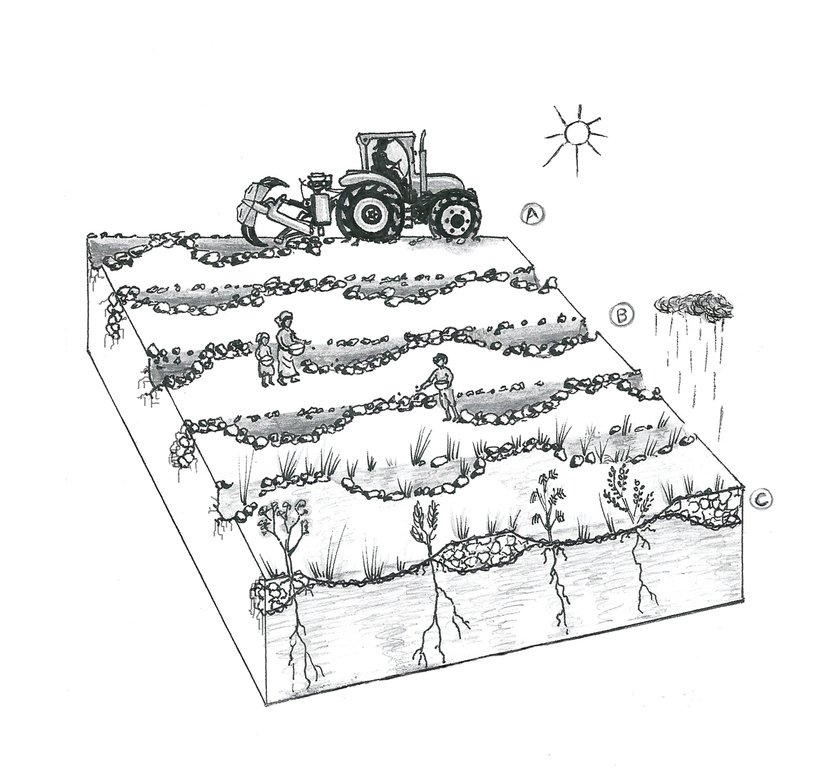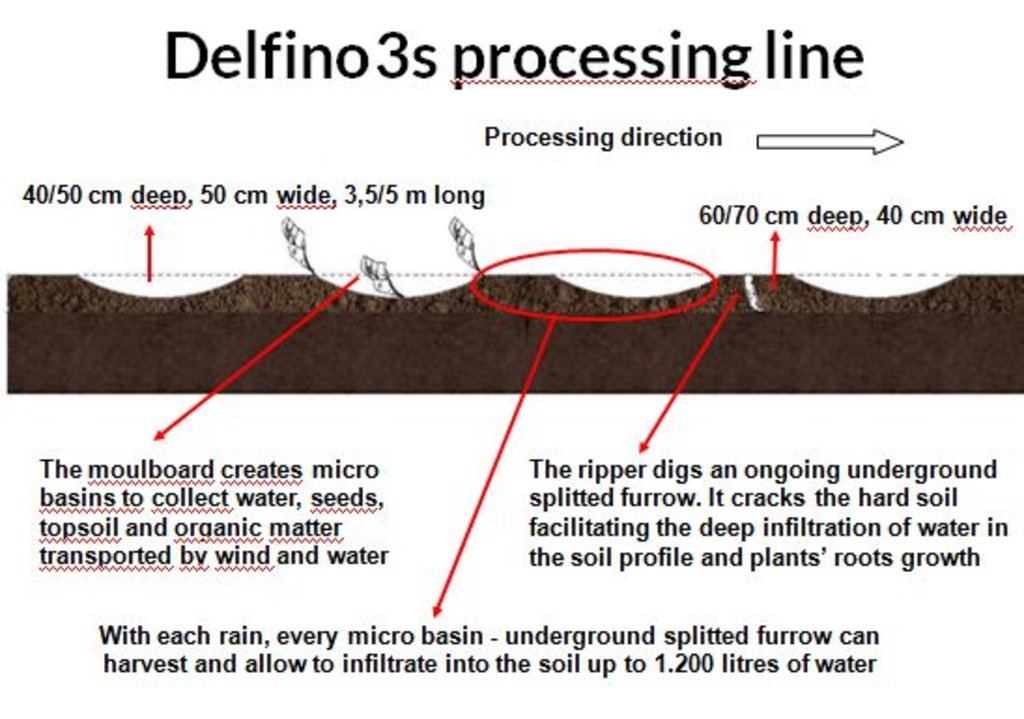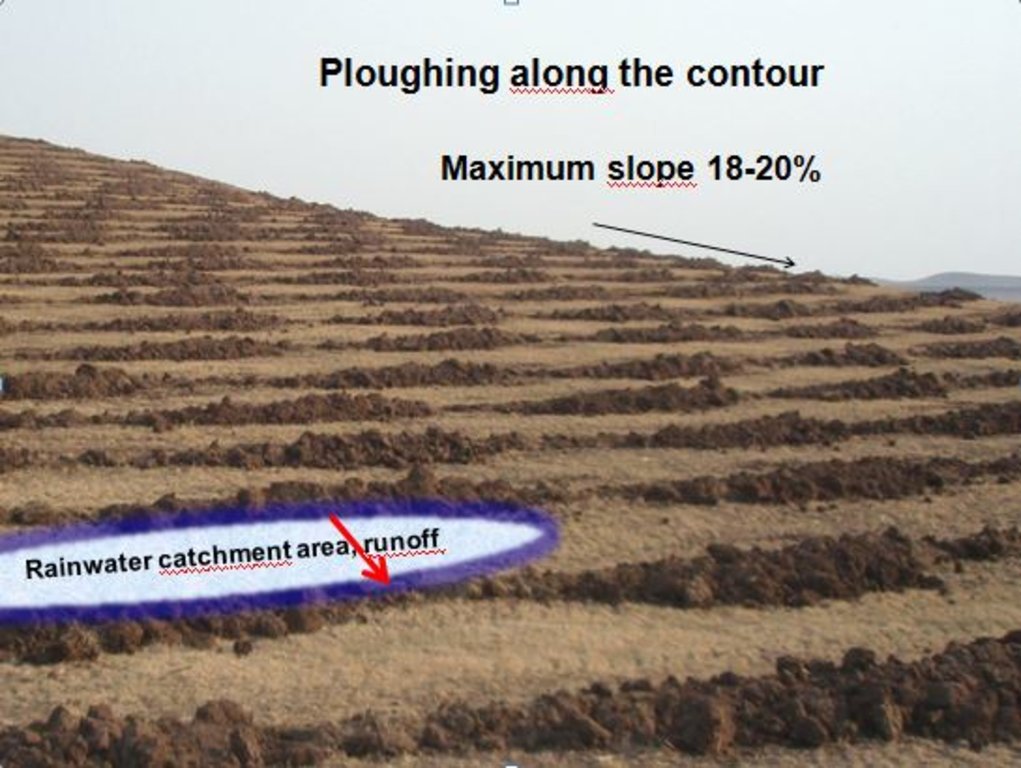Le système Vallerani [Burkina Faso]
- Création :
- Mise à jour :
- Compilateur : Sabina Galli Vallerani
- Rédacteur : –
- Examinateurs : Rima Mekdaschi Studer, Donia Mühlematter
technologies_1528 - Burkina Faso
- Résumé complet en PDF
- Résumé complet en PDF pour impression
- Résumé complet dans le navigateur
- Résumé complet (non formaté)
- Le système Vallerani: 8 mars 2019 (public)
- Le système Vallerani: 16 juillet 2018 (inactive)
- Le système Vallerani: 16 juillet 2018 (inactive)
- Le système Vallerani: 12 juillet 2018 (inactive)
- Le système Vallerani: 15 août 2018 (inactive)
- Le système Vallerani: 4 avril 2018 (inactive)
- Le système Vallerani: 4 janvier 2017 (inactive)
Voir les sections
Développer tout Réduire tout1. Informations générales
1.2 Coordonnées des personnes-ressources et des institutions impliquées dans l'évaluation et la documentation de la Technologie
exploitant des terres:
Long Allain
Reach Afrique, NGO
Burkina Faso
Spécialiste GDT:
Lindo Grandi
Deserto Verde Burkinabé, NGO
Suisse
exploitant des terres:
Boureima Amadou
Reach Afrique
Burkina Faso
Nom du projet qui a facilité la documentation/ l'évaluation de la Technologie (si pertinent)
Book project: Water Harvesting – Guidelines to Good Practice (Water Harvesting)Nom du ou des institutions qui ont facilité la documentation/ l'évaluation de la Technologie (si pertinent)
Reach Africa (Reach Africa)Nom du ou des institutions qui ont facilité la documentation/ l'évaluation de la Technologie (si pertinent)
Reach Italia (Reach Italia) - Italie1.3 Conditions relatives à l'utilisation par WOCAT des données documentées
Quand les données ont-elles été compilées (sur le terrain)?
2012/2018
Le compilateur et la(les) personne(s) ressource(s) acceptent les conditions relatives à l'utilisation par WOCAT des données documentées:
Oui
1.4 Déclaration sur la durabilité de la Technologie décrite
Est-ce que la Technologie décrite ici pose problème par rapport à la dégradation des terres, de telle sorte qu'elle ne peut pas être déclarée comme étant une technologie de gestion durable des terres?
Non
2. Description de la Technologie de GDT
2.1 Courte description de la Technologie
Définition de la Technologie:
Une charrue spéciale tirée par un tracteur forme automatiquement des petits captages d’eau ; cette technologie est parfaitement adaptée aux travaux de régénération à grande échelle.
2.2 Description détaillée de la Technologie
Description:
L’outil Vallerani est une charrue modifiée, appelée Delfino3 et tirée par un tracteur de grande puissance. En terrain plat, une charrue classique trace des sillons symétriques, la terre s’accumulant des deux côtés du sillon. La charrue Delfino3 n’a qu’un soc réversible qui créé un sillon anguleux et qui n’accumule la terre que du côté aval. Cette terre forme un rebord qui empêche ou ralenti le ruissellement vers l’aval. Le soc de la charrue monte et descend (il rentre et sort de la terre), créant des micro-bassins d’environ 5 m de long, 50 cm de profondeur et espacés de 2 m, chacun avec un rebord. Deux rippers placés à l’avant de la charrue travaillent le sol à une profondeur de 70 cm, se relevant avant les cuvettes et redescendant entre elles, formant ainsi une poche de rétention pour l’eau qui s’écoule directement des cuvettes. Même avec de très faibles pluviométries (150-500 mm/an), chaque micro-captage/poche de réserve peut récolter 1’500 litres d’eau, y compris le ruissellement. Cette eau est protégée de l’évaporation et reste disponible pour les racines des plantes et les aquifères.
Le Systeme Vallerani (VS) est basé sur un semis direct de graines de buissons et d’arbres indigènes disponibles sur place. Ils sont semés sur les bords des cuvettes et dans le sillon du ripper. Dans la zone de l’étude de cas, Acacia tortilis, Ziziphus mauritania, Balanites aegyptiaca, Acacia senegal, Acacia seyal et Faidherbia albida ont été semés. Bien que la plupart des graines peuvent être récoltées par la population locale, il est nécessaire d’acheter les graines chez des pépiniéristes pour certaines espèces rares dans la région. L’utilisation de fumier de chèvre contenant des graines et semé directement s’est aussi montrée efficace (au moins un arbre pousse dans environ 95% des micro-bassin). Le surplus d’humidité maintenu longtemps à disposition des arbres leur permet de pousser rapidement ; la couverture herbacée s’améliore, en qualité et en quantité, fournissant 20-30 fois plus de fourrage (1'000-2'000 kg de biomasse sèche/ha/an), contribuant aussi à la conservation des sols. La zone labourée et semée n’est pas clôturée ; le pâturage par les animaux est autorisé afin que les villageois puissent profiter du fourrage, réduisant ainsi l’accumulation de biomasse combustible qui augmenterait encore le risque d’incendie en saison sèche.
En une journée, la charrue Vallerani peut « traiter » jusqu’à 20 ha, creusant 5'720 micro-bassins. Les atouts de la charrue Delfino3 sont sa vitesse et son efficacité dans la lutte contre la désertification, mais ils peuvent aussi être un facteur limitant majeur car, pour en tirer le maximum, il faut trouver de grandes surfaces de terres à reboiser ou à cultiver, ce qui n’est faisable qu’au moyen d’initiatives publiques ou d’entreprises. La diffusion « en traînée de poudre » propre à cette étude de cas s’est faite grâce à la présence sur le territoire d’une OGN déjà active et implantée depuis de nombreuses années, et par la persévérance, le respect et les compétences du partenaire « du Nord ». Une fois que le projet a investi dans le tracteur et la charrue (tracteur ~ 70'000 EUR, charrue ~ 40'000 EUR), les autres coûts de mise en œuvre – main d’œuvre locale et conducteurs, carburant, etc. sont d’environ EUR 125 / ha / an.
La zone d’étude de cas, dans le nord-est du Burkina Faso, reçoit 300-500 mm de précipitations par an. Les sols de cette région agro-pastorale sont fortement dégradés avec une faible densité d’arbres et une absence quasi-totale de couverture herbacée.
2.3 Photos de la Technologie
2.4 Vidéos de la Technologie
Commentaire, brève description:
A short video that introduces the Vallerani System.The video has been shot in the project area.
Date:
14/05/2014
Lieu:
Oudalan, Burkina Faso
Nom du vidéaste:
Jonathan van Laamsverde
Commentaire, brève description:
The presentation of the ICARDA Minared project applying the Vallerani System for rangeland rehabilitation in the Jordan Badia.
Date:
16/06/2016
Lieu:
Badia, Jordan
Commentaire, brève description:
Reach Italia and Deserto Verde Burkinabé present the project of soil rehabilitation and food security in Burkina Faso. Italian text.
Date:
01/09/2009
Lieu:
Oudalan, Burkina Faso
2.5 Pays/ région/ lieux où la Technologie a été appliquée et qui sont couverts par cette évaluation
Pays:
Burkina Faso
Région/ Etat/ Province:
Oudalan
Autres spécifications du lieu:
Gorom-Gorom
Commentaires:
Since the project is going on since 2002, it is possible to see implemented sites in different stadium of rehabilitation. The plowing lines are clearly visible.
Map
×2.6 Date de mise en œuvre de la Technologie
Si l'année précise est inconnue, indiquez la date approximative: :
- il y a entre 10-50 ans
2.7 Introduction de la Technologie
Spécifiez comment la Technologie a été introduite: :
- au cours d'expérimentations / de recherches
- par le biais de projets/ d'interventions extérieures
Commentaires (type de projet, etc.) :
The Technology was introduced in the Region in an agro-sylvo-pastoral pilot project to fight against desertification by FAO in 1996-97.
3. Classification de la Technologie de GDT
3.1 Principal(aux) objectif(s) de la Technologie
- améliorer la production
- réduire, prévenir, restaurer les terres dégradées
- conserver/ améliorer la biodiversité
- s'adapter au changement et aux extrêmes climatiques et à leurs impacts
- atténuer le changement climatique et ses impacts
- créer un impact économique positif
- créer un impact social positif
3.2 Type(s) actuel(s) d'utilisation des terres, là où la Technologie est appliquée

Pâturages
Pâturage extensif:
- Semi-nomadisme/ pastoralisme
Principales espèces animales et principaux produits:
Goats, cattle
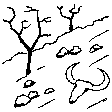
Terres improductives
Précisez:
Hard abbandoned land
Remarques:
Especially at the beginning of the project, some communities agreed to try the system on their most unproductive land. After seeing the results, they started to request the intervention on less degraded soil and on fields that are closer to their villages.
Commentaires:
Problèmes: le problème principal est la dégradation-désertification avec diminution du couvert végétal en termes de densité de plantes et d’espèces : disparition de l’herbe et des arbres, diminution de la taille des plantes résistantes et de l’activité biologique du sol. Augmentation du ruissellement, de l’érosion éolienne et hydrique. Sécheresse et précipitations irrégulières avec conséquences graves sur la fertilité du sol, la disponibilité en eau pour les humains et le bétail, la recharge des aquifères.
3.3 Informations complémentaires sur l'utilisation des terres
Approvisionnement en eau des terres sur lesquelles est appliquée la Technologie:
- pluvial
Nombre de période de croissance par an: :
- 1
Précisez:
90 jours
3.4 Groupe de GDT auquel appartient la Technologie
- agroforesterie
- pastoralisme et gestion des pâturages
- récupération/ collecte de l'eau
3.5 Diffusion de la Technologie
Spécifiez la diffusion de la Technologie:
- répartie uniformément sur une zone
Si la Technologie est uniformément répartie sur une zone, indiquez la superficie couverte approximative:
- 100-1 000 km2
Commentaires:
Total area covered by the SLM Technology in the Region is about 25.600 hectares up to 2017.
3.6 Mesures de GDT constituant la Technologie

pratiques végétales
- V1: Couverture d’arbres et d’arbustes
- V2: Herbes et plantes herbacées pérennes

structures physiques
- S2: Diguettes, digues
- S4: Fossés isohypses, trous

modes de gestion
- M1: Changement du type d’utilisation des terres
- M2: Changement du niveau de gestion / d'intensification
- M3: Disposition/plan en fonction de l'environnement naturel et humain
3.7 Principaux types de dégradation des terres traités par la Technologie

érosion hydrique des sols
- Wt: perte de la couche superficielle des sols (couche arable)/ érosion de surface
- Wg: ravinement/ érosion en ravines
- Wo: effets hors-site de la dégradation

érosion éolienne des sols
- Et: perte de la couche superficielle des sols (couche arable)
- Eo: effets hors site de la dégradation

dégradation chimique des sols
- Cn: baisse de la fertilité des sols et réduction du niveau de matière organique (non causée par l’érosion)

dégradation physique des sols
- Pc: compaction
- Pk: scellage et encroûtement
- Pi: imperméabilisation des sols
- Pu: perte de la fonction de bio-production en raison d’autres activités

dégradation biologique
- Bc: réduction de la couverture végétale
- Bh: perte d’habitats
- Bq: baisse de la quantité/ biomasse
- Bs: baisse de la qualité et de la composition/ diversité des espèces
- Bl: perte de la vie des sols

dégradation hydrique
- Ha: aridification
- Hg: changement du niveau des nappes phréatiques (eaux souterraines) et des aquifères
Commentaires:
Causes de dégradation: surexploitation de la végétation pour l’usage domestique, surpâturage, changement des précipitations saisonnières, sécheresses, déforestation / disparition de la végétation naturelle (inclus les feux de forêts), éducation, accès à la connaissance et aux conseils
3.8 Prévention, réduction de la dégradation ou réhabilitation des terres dégradées
Spécifiez l'objectif de la Technologie au regard de la dégradation des terres:
- réduire la dégradation des terres
- restaurer/ réhabiliter des terres sévèrement dégradées
4. Spécifications techniques, activités, intrants et coûts de mise en œuvre
4.1 Dessin technique de la Technologie
4.2 Spécification/ explications techniques du dessin technique
(en haut) A. La parcelle choisie avec la population locale est labourée avec la charrue spéciale Delfino3. B. Les habitants locaux sèment des graines (récoltées sur les arbres de la région ou achetées si les espèces sont rares) ou du fumier de chèvre qui contient des graines (récolté dans les enclos de nuit après avoir secoué les arbres pour faire tomber les graines mûres, que les chèvres mangent). C. Les micro-bassins récoltent la pluie qui tombe dans les croissants et 50% de l’eau de ruissellement. L’eau pénètre facilement dans le sol, remplit les poches de rétention, reste disponible pour les racines des plantes et s’infiltre dans les nappes phréatiques sans risque d’évaporation. Chaque micro-bassin/poche de rétention peut récolter jusqu’à 1'500 l of water.
(en bas) h1 - profondeur de travail du soc = 40/50 cm ; largeur du micro-bassin = 40/50 cm ; L1 - longueur du micro-bassin, programmable = 3,5/5 m ; h2 - profondeur de travail des rippers = 50/80 cm ; P- longueur totale du travail = 4/8 m. Puissance du tracteur 210/250CV (150-198 KW) ; vitesse de travail : 4/7 Km/h ; poids 2'000 kg
Location: Gorom Gorom, Oudalan. Burkina Faso
Main technical functions: contrôle de la battance (‘splash’), amélioration de la couverture du sol, amélioration de la structure de la couche arable du sol (tassement, compaction), stabilisation du sol (par ex. par des racines d’arbres contre les glissements de terrain), récupération de l’eau / augmentation des réserves d’eau, augmentation de la biomasse (quantité), développement des espèces végétales et de la variété (qualité, ex: fourrage appétent)
Secondary technical functions: augmentation de la matière organique, augmentation de la disponibilité des nutriments (réserve, recyclage, …), augmentation de l'infiltration, augmentation / maintien de la rétention d'eau dans le sol
4.3 Informations générales sur le calcul des intrants et des coûts
Spécifiez la manière dont les coûts et les intrants ont été calculés:
- par superficie de la Technologie
Indiquez la taille et l'unité de surface:
100 hectares
Indiquez la monnaie utilisée pour le calcul des coûts:
- dollars US
Indiquez le coût salarial moyen de la main d'œuvre par jour:
2.5
4.4 Activités de mise en place/ d'établissement
| Activité | Type de mesures | Calendrier | |
|---|---|---|---|
| 1. | Planification du projet, conseil et formation SV et experts nationaux | Autres mesures | Before starting |
| 2. | Labour avec charrue spéciale Delfino, tirée par un tracteur de 210CV | Structurel | Saison sèche |
| 3. | 3. Récolte des graines effectuée par la population locale, soit en les récoltant sur les plantes, soit en secouant les arbres au bon moment pour en nourrir les chèvres et moutons, pour collecter le fumier dans l’enclos de nuit | Agronomique | When seeds are ripe |
| 4. | Le reste des graines peut être acheté dans les marchés locaux ou, si les arbres sont rares ou l’espèce a disparu, chez un pépiniériste | Agronomique | Quand les graines sont mûres |
| 5. | Semis direct | Agronomique | Saison sèche |
4.5 Coûts et intrants nécessaires à la mise en place
| Spécifiez les intrants | Unité | Quantité | Coûts par unité | Coût total par intrant | % du coût supporté par les exploitants des terres | |
|---|---|---|---|---|---|---|
| Main d'œuvre | main d'oevre | ha | ||||
| Equipements | usage de machines | ha |
Si le coût n'est pas pris en charge à 100% par l'exploitant des terres, indiquez qui a financé le coût restant:
Founders
Commentaires:
The actual (2018) average cost of the implementation is $ 170 per hectare. This cost can be considerably reduced by around 22% in the case of an optimal use of the Technical Mechanization Unit, ie 800-1000 hours of work per year. This means that an operator who works with the plow Delfino has a gross investment cost which can vary according to its technical and organizational experience and by the amount of the plowed surface each year.
4.6 Activités d'entretien/ récurrentes
| Activité | Type de mesures | Calendrier/ fréquence | |
|---|---|---|---|
| 1. | Pas d’activités d’entretien | Végétale | After the rain and in the dry season |
| 2. | Vegetation growth management | Végétale | During the first 3-5 years |
| 3. | Woodcut management | Végétale | After 4-7 years |
| 4. | Equipment maintenance (plow, tactor) | Modes de gestion | Daily, weekly, seasonal |
4.7 Coûts et intrants nécessaires aux activités d'entretien/ récurrentes (par an)
Si le coût n'est pas pris en charge à 100% par l'exploitant des terres, indiquez qui a financé le coût restant:
Founders
Commentaires:
Toutes les données du tableau concernent un projet idéal qui dure 5 ans avec 3'000 hectares labourés chaque année. Tous les travaux effectués donnent lieu à rétribution économique. Le point 1 fait référence à la planification, à la formation et aux conseillers techniques/ingénieurs consultants, qui ont un fort impact sur le coût à l’ha ($47). Cette valeur resterait identique si 3MTU (Mechanized Technical Unit) étaient utilisées dans la même zone, réduisant le coût à $ 15,6 par ha.
4.8 Facteurs les plus importants affectant les coûts
Décrivez les facteurs les plus importants affectant les coûts :
Le coût initial d’acquisition du matériel est d’environ 40'000 EUR pour la charrue et de 70'000 EUR pour le tracteur.
5. Environnement naturel et humain
5.1 Climat
Précipitations annuelles
- < 250 mm
- 251-500 mm
- 501-750 mm
- 751-1000 mm
- 1001-1500 mm
- 1501-2000 mm
- 2001-3000 mm
- 3001-4000 mm
- > 4000 mm
Spécifications/ commentaires sur les précipitations:
400-600 mm
Indiquez le nom de la station météorologique de référence considérée:
Dori, Burkina Faso
Zone agro-climatique
- semi-aride
- aride
Thermal climate class: subtropics. Average temperature 30°C
5.2 Topographie
Pentes moyennes:
- plat (0-2 %)
- faible (3-5%)
- modéré (6-10%)
- onduleux (11-15%)
- vallonné (16-30%)
- raide (31-60%)
- très raide (>60%)
Reliefs:
- plateaux/ plaines
- crêtes
- flancs/ pentes de montagne
- flancs/ pentes de colline
- piémonts/ glacis (bas de pente)
- fonds de vallée/bas-fonds
Zones altitudinales:
- 0-100 m
- 101-500 m
- 501-1000 m
- 1001-1500 m
- 1501-2000 m
- 2001-2500 m
- 2501-3000 m
- 3001-4000 m
- > 4000 m
Indiquez si la Technologie est spécifiquement appliquée dans des:
- non pertinent
5.3 Sols
Profondeur moyenne du sol:
- très superficiel (0-20 cm)
- superficiel (21-50 cm)
- modérément profond (51-80 cm)
- profond (81-120 cm)
- très profond (>120 cm)
Texture du sol (de la couche arable):
- grossier/ léger (sablonneux)
- moyen (limoneux)
Texture du sol (> 20 cm sous la surface):
- grossier/ léger (sablonneux)
- moyen (limoneux)
Matière organique de la couche arable:
- faible (<1%)
5.4 Disponibilité et qualité de l'eau
Profondeur estimée de l’eau dans le sol:
> 50 m
Disponibilité de l’eau de surface:
moyenne
Qualité de l’eau (non traitée):
faiblement potable (traitement nécessaire)
La salinité de l'eau est-elle un problème? :
Non
La zone est-elle inondée?
Non
Commentaires et précisions supplémentaires sur la qualité et la quantité d'eau:
Generally the watertable is lowering. Surface water is collected in boulies (ponds) for livestock and household activities. Its quality deteriorates during the dry season and its quantity decreases fast.
5.5 Biodiversité
Diversité des espèces:
- faible
Diversité des habitats:
- faible
Commentaires et précisions supplémentaires sur la biodiversité:
Up to 30-50 years ago biodiversity was reach and soil coverage higher.
5.6 Caractéristiques des exploitants des terres appliquant la Technologie
Sédentaire ou nomade:
- Semi-nomade
Orientation du système de production:
- subsistance (auto-approvisionnement)
Revenus hors exploitation:
- moins de 10% de tous les revenus
Niveau relatif de richesse:
- très pauvre
- pauvre
Individus ou groupes:
- groupe/ communauté
Niveau de mécanisation:
- travail manuel
Genre:
- femmes
- hommes
Age des exploitants des terres:
- jeunes
- personnes d'âge moyen
Indiquez toute autre caractéristique pertinente des exploitants des terres:
Le projet comprend la reforestation et la reconstruction de la strate herbacée du pâturage pour le bétail, qui sont des activités effectuées par les hommes. Depuis 2010, les femmes ont semé des plantes spéciales à usage médicale, domestique et comme matière première pour l'artisanat et les a protégées du pâturage.
La seule activité des habitants de la région est l’élevage de chèvres et de vaches. Les cultures ne servent qu’à la subsistance.
5.7 Superficie moyenne des terres détenues ou louées par les exploitants appliquant la Technologie
- < 0,5 ha
- 0,5-1 ha
- 1-2 ha
- 2-5 ha
- 5-15 ha
- 15-50 ha
- 50-100 ha
- 100-500 ha
- 500-1 000 ha
- 1 000-10 000 ha
- > 10 000 ha
Cette superficie est-elle considérée comme de petite, moyenne ou grande dimension (en se référant au contexte local)?
- petite dimension
5.8 Propriété foncière, droits d’utilisation des terres et de l'eau
Propriété foncière:
- état
- communauté/ village
Droits d’utilisation des terres:
- accès libre (non organisé)
- communautaire (organisé)
Droits d’utilisation de l’eau:
- accès libre (non organisé)
- communautaire (organisé)
5.9 Accès aux services et aux infrastructures
santé:
- pauvre
- modéré
- bonne
éducation:
- pauvre
- modéré
- bonne
assistance technique:
- pauvre
- modéré
- bonne
emploi (par ex. hors exploitation):
- pauvre
- modéré
- bonne
marchés:
- pauvre
- modéré
- bonne
énergie:
- pauvre
- modéré
- bonne
routes et transports:
- pauvre
- modéré
- bonne
eau potable et assainissement:
- pauvre
- modéré
- bonne
services financiers:
- pauvre
- modéré
- bonne
6. Impacts et conclusions
6.1 Impacts sur site que la Technologie a montrés
Impacts socio-économiques
Production
production agricole
Quantité après la GDT:
2-4 times
Commentaires/ spécifiez:
Crop production and biomass augmented 2-4 times compared with traditional cultural techniques.
production fourragère
Quantité avant la GDT:
90kg/MS/ha
Quantité après la GDT:
1250kg/MS/ha
Commentaires/ spécifiez:
Grass fodder production increased by a factor of 5–30 compared with unmanaged land. The production of herbaceous biomass varied from 420 kg to 2.090 kg (dry matter) per ha; thus, on average, 1.250 kg of herbaceous biomass (dry matter) per ha developed on sites where the Vallerani system was deployed, compared with an average of 90 kg (dry matter) per ha in control plots. Vegetation is mainly distributed inside and around the micro basins.
qualité des fourrages
Quantité avant la GDT:
12 floral species
Quantité après la GDT:
44 floral species
Commentaires/ spécifiez:
The application of the Technology boosts a regenaration process increasing year by year. Compared to the surrounding control rangelands, fodder quality and biodiversity increased with a high proportion of grassland species of good forage value, such as Panicum laetum and Schonefeldia gracilis, and the return of legume species such as Alysicarpus ovalifolius and Zornia glochidiata also testify the improvement of the quality of the reconstituted pastures.
production animale
Commentaires/ spécifiez:
The increase of fodder quantity and quality represents a surplus of 22–106 grazing days per tropical cattle unit per hectare. This extra fodder supply reduces the need to make long-range transhumance or cut shrubs to meet livestock needs for fodder, even in years where pasture is low. Livestock is fed with more and better quality fodder so its productivity and market price increase.
production de bois
qualité des forêts/ bois
Quantité avant la GDT:
20 trees/ha of 6 species
Quantité après la GDT:
700 trees/ha of 14 species
Commentaires/ spécifiez:
Significant improvement in forest cover (700 live trees and shrubbs per ha, on average) and biodiversity: trees are capable of spontaneous growth even with open access to grazing and in years of high water stress.
production forestière non ligneuse
Commentaires/ spécifiez:
Berries, gum arabica, resins, fruits.
risque d'échec de la production
Commentaires/ spécifiez:
The increased fodder quantity, quality and biodiversity, the deep root system of the sown plants, increase resilience of the ecosystem and reduce the risk of production failure. The increased biodiversity, soil moisture and fertility increase the resilience of plants to attacks by pests, deseases and drought. Even in the case of severe drought, there are some plants that can be used as "emergency food" by humans and animals.
diversité des produits
Commentaires/ spécifiez:
The implementation of the Technology gives the opportunity to diversify the production. Next to animal breeding, agriculture has intensified and in some villages the production of handicrafts, food processing, hunting and tourism activities are developping. Berries, gum arabica, resins, fruits enrich the family diet or can be sold at markets. Wild animals, insects, reptiles and birds have returned after decades and greatelly increased.
surface de production
Quantité après la GDT:
25.600ha
Commentaires/ spécifiez:
By the end of 2017 about 25.600 hectares of severelly degraded, abbandoned land has been rehabilitated.
Disponibilité et qualité de l'eau
disponibilité de l'eau potable
Commentaires/ spécifiez:
Local people attest that the rehabilitation of large areas of bare soil augmented the local rain amount and the water level in the wells.
disponibilité de l'eau pour l'élevage
Commentaires/ spécifiez:
The rain collected in the micro basins is available for livestock during the rainy season. The augmented rainfall also increases water availability in boulies (ponds).
demande pour l'eau d'irrigation
Commentaires/ spécifiez:
No water is needed for the Technology except for rain.
Revenus et coûts
dépenses pour les intrants agricoles
Commentaires/ spécifiez:
The implementation cost of the technology is not entirelly sustainable by Communities. donors and founders sustain the project. Large-scale application reduces the cost per hectare and increases the impact of actions in reversing the degradation–desertification trend. The cost of each plowed hectare.
revenus agricoles
Commentaires/ spécifiez:
Fodder increase in quality and quantity, improve animal health and productivity as well as their market price.
diversité des sources de revenus
Commentaires/ spécifiez:
The Technology increases income for herders and their families also thanks to diversification. More land is also used for agriculture. Selling or transformation of other products such as berries, fruits, gums, resins; hunting; new job opportunities in disadvantaged areas such as tractor drivers, social promoters, seed collectors...The community raises awareness and a potential for small business activities occurs, mainly among women.
disparités économiques
Commentaires/ spécifiez:
Disadvantaged groups such as women start new economic activities such as mat production and sale at markets, medical plants and food production. They diversify their income and improve their status in the community.
charge de travail
Quantité avant la GDT:
5 micro basins/day
Quantité après la GDT:
6.000 micro basins/day
Commentaires/ spécifiez:
Each man can dig 5 micro basins per day doing a heavy work. The plow can dig 6.000-7.000 micro basins per day. As most rangelands, the area of the project has a low human density (29 inhabitants/km2) so people are responsible for seed collection and storage, sowing, the livestock management during the first growing phase, monitoring activities, a.s.o.
Autres impacts socio-économiques
Migration
Commentaires/ spécifiez:
Increased and improved fodder availability reduces the need for long-range tranhumance and seasonal or definitive migration to areas with more work opportunities (e.g. mines), cities or other countries.
Impacts socioculturels
sécurité alimentaire/ autosuffisance
Commentaires/ spécifiez:
Food security improves with increased and diversified productivity and income. The increased fodder and crop quantity, quality and biodiversity, the deep root system and soil fertility, increase the resilience of the whole ecosystem. Even in the case of severe drought, there are some plants that can be used as "emergency food" by humans and animals.
situation sanitaire
Commentaires/ spécifiez:
Improved health especially due to better nutrition also for disadvantaged groups such as children and old people: bigger amounts, diversification, milk, vegetables. The reduction of dust storms also improves the health situation.
droits d'utilisation des terres/ de l'eau
Commentaires/ spécifiez:
Awareness rising and discussion of the theme are essential. Due to the great productivity of former degraded and often abandoned land, land use rules and water rights are clearly discussed and defined at the beginning of the project. Rules for SLM are adopted and respected by all; for example, it is forbidden to install camps in or near restored areas, to cut trees, and to mow for commercial purposes.
possibilités de loisirs
Commentaires/ spécifiez:
Shadow, green areas near the villages increase recreational opportunities.
institutions communautaires
Commentaires/ spécifiez:
It is essential to involve and give responsibility to local people in every step of the process. Comities and groups such as the women or seniors groups gain relevance and become essential for the sustainability of the project.
institutions nationales
Commentaires/ spécifiez:
Collaborations with national institutions such as forestry direction, ministery of environnement and agricolture, research institutes, etc
connaissances sur la GDT/ dégradation des terres
Commentaires/ spécifiez:
All communities are involved in the management process – identifying the areas and the use of the sites to be restored, planning, and implementing (e.g. gathering and keeping seeds of local ecotypes, manure and sowing). Local villages are involved in the care and defence of new plantations and in the monitoring and evaluation of the results of vegetation growth. Ultimatelly they become responsable for the sustainable management of the whole area.
apaisement des conflits
Commentaires/ spécifiez:
If land use and water rights are clearly defined, the increased availability of fodder reduces conflicts with neighbours and farmers.
situation des groupes socialement et économiquement désavantagés
Community well being
Commentaires/ spécifiez:
People have more confidence in the future, dignity and hope. The Community cohesion and identity is strenghtened and the community becomes more resilient to conflicts and disasters.
Impacts écologiques
Cycle de l'eau/ ruissellement
quantité d'eau
Quantité après la GDT:
360.000l/ha
Commentaires/ spécifiez:
With each rain, each micro basin can collect up to 1.200l of water. Each hectare collects an average of 360.000 liter of rain, runoff included. Collected in the micro basin, the water has enough time to infiltrate in the soil profile and eventually in the water table. Local people assert that after the implementation of the Technology, the water level in the wells has raised.
récolte/ collecte de l'eau
Commentaires/ spécifiez:
The Technology allows to harvest 100% of the rain falling in the micro basin and on the ripped furrow as well as up to 90% of the rain falling between the tilled lines. The bare soil between the tilled lines is essential as catchment area, to recieve rainfall and process runoff downstream. The micro basins collect up to 95% of rainfall.
ruissellement de surface
Quantité avant la GDT:
5-15%
Quantité après la GDT:
90%
Commentaires/ spécifiez:
Plowing is done along the contour. This is essential to collect the runoff that flows between the tilled lines (catchment area). The distance between the lines can be between 4m and 12m depending from: slope, rain characteristics (quantity, intensity), soil type, surface roughness (runoff coheficient), the purpose of the project (type of plants desired). The technology allows to collect up to 90% of the runoff.
nappes phréatiques/ aquifères
Commentaires/ spécifiez:
Local people assert that after the implementation of the technology, the water level in the wells has raised.
évaporation
Commentaires/ spécifiez:
The rain collected in the micro basins infiltrates in the soil profile being accessible for seeds and roots without evaporating. After the first rains, the micro basins are quickly covered with high grasses that contribute to reduce evaporation.
Sols
humidité du sol
Commentaires/ spécifiez:
Improved soil hydrodynamic properties: the relative size of capillaries by different soil levels increased and the soil water-retaining capability improved.
couverture du sol
perte en sol
Commentaires/ spécifiez:
Reduced soil loss through runoff reduction and wind erosion.
compaction du sol
Quantité avant la GDT:
423
Quantité après la GDT:
70
Commentaires/ spécifiez:
At different depth soil compactness reduces from 6 (0 to 20cm) to 1.3 times (40 to 60cm)
cycle/ recharge des éléments nutritifs
matière organique du sol/ au dessous du sol C
Biodiversité: végétale, animale
Couverture végétale
Commentaires/ spécifiez:
Vegetation cover increase 5 to 30 times. Vegetation grows mainly inside and around the micro basins.
biomasse/ au dessus du sol C
Quantité avant la GDT:
70 to 110kg/MS/ha
Quantité après la GDT:
420 to 2090 kg/MS/ha
Commentaires/ spécifiez:
The biomass production increases 5 to 30 times compared to the nearby unplowed soil. On implemented sites, biomass varies from 420 to 2090 kg / DM / ha, on average between 1000 and 1200 kg / ha against 70 to 110kg / DM / ha on control plots.
diversité végétale
Quantité avant la GDT:
14 herbaceous, 6 woody species/ha
Quantité après la GDT:
44 herbaceous, 14 woody species/ha
Commentaires/ spécifiez:
Floral diversity increases from 14 to 44 species. With a high proportion of graminaceous species of good forage value and the return of more leguminous species. Concerning the diversity of woody plants the results show an average per hectare of 14 species on implemented sites and an average of 6 species on control plots.
diversité animale
Commentaires/ spécifiez:
A great increase of animal biodiversity: insects, birds, reptiles and mammals (such as squirrel, jackals, gazelle...) are observed in the implemented sites.
contrôle des animaux nuisibles/ maladies
Commentaires/ spécifiez:
The increased vegetal and animal biodiversity, deep root system, soil fertility and water availability, increase the health and resilience capacity of the whole ecosystem.
Réduction des risques de catastrophe et des risques climatiques
impacts des inondations
Commentaires/ spécifiez:
Through water harvesting the rain is retained in the precipitation area and flood risk decreases. If flood occurs in the plowed area before the vegetation is well established, the micro basins can be washed out.
impacts de la sécheresse
Commentaires/ spécifiez:
Increased biodiversity, vegetation cover and soil fertility, deep root system and water storage in the soil profile, increase the resilience to drought of the whole ecosystem. During the project, in years of extreme drought, plants have reduced their growth but most of them survived, were used to feed animals and started growing again in the following rainy season.
émissions de carbone et de gaz à effet de serre
Commentaires/ spécifiez:
Minimal production of carbon dioxide compared with the potential gain.
risques d'incendies
Commentaires/ spécifiez:
The implementing area remains open to lifestock (regulated pasture) to reduce the high production of grass that could favor the spread of a fire, herders also monitor the territory. There is a high level of community involvement and a growing ecological awareness.
vitesse du vent
Commentaires/ spécifiez:
The great number of growing trees reduce the wind speed.
microclimat
Commentaires/ spécifiez:
Local people attest that the Technology locally increased the amount of rain and reduced dust storms in number and intensity.
6.2 Impacts hors site que la Technologie a montrés
disponibilité de l'eau
Commentaires/ spécifiez:
Local people tell that the rehabilitation of large areas of bare soil augmented the local rain amount and the water level in the wells.
sédiments (indésirables) transportés par le vent
Commentaires/ spécifiez:
Wind intensity and dust storms reduction thanks to soil coverage and wind brake effect by trees and shrubs.
6.3 Exposition et sensibilité de la Technologie aux changements progressifs et aux évènements extrêmes/catastrophes liés au climat (telles que perçues par les exploitants des terres)
Changements climatiques progressifs
Changements climatiques progressifs
| Saison | Type de changements/ extrêmes climatiques | Comment la Technologie fait-elle face à cela? | |
|---|---|---|---|
| températures annuelles | augmente | très bien | |
| températures saisonnières | saison sèche | augmente | très bien |
| précipitations annuelles | décroît | bien | |
| précipitations saisonnières | saison des pluies/ humide | décroît | bien |
Extrêmes climatiques (catastrophes)
Catastrophes météorologiques
| Comment la Technologie fait-elle face à cela? | |
|---|---|
| pluie torrentielle locale | modérément |
| tempête de sable/ de poussière locale | très bien |
| tempête de vent locale | très bien |
Catastrophes hydrologiques
| Comment la Technologie fait-elle face à cela? | |
|---|---|
| crue éclair | pas bien |
Catastrophes biologiques
| Comment la Technologie fait-elle face à cela? | |
|---|---|
| infestation par des insectes/ vers | bien |
6.4 Analyse coûts-bénéfices
Quels sont les bénéfices comparativement aux coûts de mise en place (du point de vue des exploitants des terres)?
Rentabilité à court terme:
positive
Rentabilité à long terme:
très positive
Quels sont les bénéfices comparativement aux coûts d'entretien récurrents (du point de vue des exploitants des terres)?
Rentabilité à court terme:
positive
Rentabilité à long terme:
très positive
Commentaires:
La mise en œuvre de la technologie est coûteuse. Après installation, l’entretien est peu coûteux et rapporte grâce à la productivité +++.
6.5 Adoption de la Technologie
- 10-50%
Si disponible, quantifiez (nombre de ménages et/ou superficie couverte):
330 villages and around 33.000 beneficiaries
Parmi tous ceux qui ont adopté la Technologie, combien d'entre eux l'ont fait spontanément, à savoir sans recevoir aucune incitation matérielle ou aucun paiement?
- 50-90%
Commentaires:
Le système comprend l’utilisation d’un tracteur puissant et d’une charrue spéciale à coût élevé, difficile à financer par la population locale. Toutes les activités en lien sont effectuées (ou peuvent l’être) sans soutien matériel externe
6.6 Adaptation
La Technologie a-t-elle été récemment modifiée pour s'adapter à l'évolution des conditions?
Oui
autre (précisez):
technical
Spécifiez l'adaptation de la Technologie (conception, matériaux/ espèces, etc.):
The design of the plow has been adapted to increase the performance of the implement and reduce the running costs of plowing. The reversibility of the plowshare reduces the need for empty rides. The different parts of the plow are adjustable to adapt it to the needs of the project and the soil characteristics.
6.7 Points forts/ avantages/ possibilités de la Technologie
| Points forts/ avantages/ possibilités du point de vue de l'exploitant des terres |
|---|
| Higly degraded, abandoned land becomes fertile and rentable again. Fodder increases in quantity and improves in quality and lasts all year round. Food security also in drought years. Herds are healthier and more productive. Fodder and water availability for animals is closer to the villages. Some plants can be sown for different uses: crops, medicine or for the production of mats or other handcrafts products that can be sold. |
| Better life conditions, more income opportunities and diversification. Food is diversified and more nutritious. Less hunger and deseases. |
| Greater community cohesion and less migration, better environnemental conciousness and commitment, education and security. People gain back dignity, confidence in the future and hope. |
| Points forts/ avantages/ possibilités du point de vue du compilateur ou d'une autre personne ressource clé |
|---|
| La pratique permet de traiter rapidement de très grandes surfaces dégradées, en peu de temps |
| Les arbres et buissons plantés sont des espèces indigènes adaptées localement |
| La technique de labour du système Vallerani offre la meilleure efficience dès les premières années après la mise en œuvre, qui ne doit pas être répétée car les effets persistent longtemps sur les parcelles |
| Le SV n’utilise pas d’eau (sauf la pluie) dans des pays où l’eau est rare et précieuse. De plus, il évite la salinisation des sols |
| Le delfino3 peut labourer des terres fortement dégradées, ce qui fait que les populations locales demandent souvent pour travailler leurs terres les plus dégradées |
6.8 Faiblesses/ inconvénients/ risques de la Technologie et moyens de les surmonter
| Faiblesses/ inconvénients/ risques du point de vue de l’exploitant des terres | Comment peuvent-ils être surmontés? |
|---|---|
| Land that was unproductive and nobody claimed becomes productive: it can lead to misunderstandigs and conflicts. | Land use and production exploitation rules must be cleared and accepted by all Subjects at the beginning of the project. |
| Good pasture attracts animals and herders from the nearby Region (also from far away and abroad). | Rules must be clear. |
| Faiblesses/ inconvénients/ risques du point de vue du compilateur ou d'une autre personne ressource clé | Comment peuvent-ils être surmontés? |
|---|---|
| Les coûts d’investissement pour les machines sont extrêmement élevés et ne peuvent financés par les exploitants individuels, ni même par les communautés | les projets doivent être financés de l’extérieur. |
| La vitesse et l’efficacité de la charrue Delfino3 sont ses grands atouts dans la lutte contre la désertification mais peuvent aussi être une limitation majeure dans sa mise en œuvre car il faut trouver de grandes surfaces à reboiser ou à cultiver | cela devient possible avec un large public ou l’initiative d’une entreprise. |
| Comme de grandes superficies sont traitées, il faut une organisation importante pour toutes les activités (sensibilisation, récolte des graines, formation du personnel, logistique, etc.) | tout cela doit être très bien organisé et opérationnel avant le début du labour |
| Les coûts d’investissement pour les machines sont extrêmement élevés et ne peuvent financés par les exploitants individuels, ni même par les communautés | les projets doivent être financés de l’extérieur. |
| Les coûts d’investissement pour les machines sont extrêmement élevés et ne peuvent financés par les exploitants individuels, ni même par les communautés | les projets doivent être financés de l’extérieur. |
7. Références et liens
7.1 Méthodes/ sources d'information
- visites de terrain, enquêtes sur le terrain
4
- interviews/entretiens avec les exploitants des terres
30
- interviews/ entretiens avec les spécialistes/ experts de GDT
8
- compilation à partir de rapports et d'autres documents existants
5
7.2 Références des publications disponibles
Titre, auteur, année, ISBN:
Conedera, M., N. Bomio-Pacciorini, et al. 2010. Reconstitution des écosystèmes dégradés sahéliens. Bois et Forêts des Tropiques 304(2).
Disponible à partir d'où? Coût?
http://www.vallerani.com/images/Reconstitution.pdf
Titre, auteur, année, ISBN:
Akhtar Ali, Theib Oweis, Atef Abdul Aal, Mohamed Mudabbar, Khaled Zubaidi, and Adriana Bruggeman. 2006. The Vallerani Water Harvesting System. ICARDA Caravan No. 23.
Disponible à partir d'où? Coût?
http://www.vallerani.com/images/Caravan-23.pdf
7.3 Liens vers les informations pertinentes disponibles en ligne
Titre/ description:
Récupération des sols fortement dégradés à des fins sylvo-pastorales, CILSS 2009
URL:
http://www.vallerani.com/wp/wp-content/uploads/2013/06/Rapport-Reach-Cills-2009.pdf
Titre/ description:
GIZ, Good practices in soil and water conservation, pag. 22 seg.
URL:
https://www.giz.de/fachexpertise/downloads/giz2012-en-soil-water-conservation.pdf
Titre/ description:
Using Mechanized Water Harvesting System (The Vallerani System ) for Rehabilitation of Degraded ASALs in Kenya
URL:
http://www.vallerani.com/wp/wp-content/uploads/2015/06/Meshack-Muga-Paper-25-Final.pdf
Titre/ description:
Report for the Sino-Italian cooperation project, SFA, China
URL:
http://www.vallerani.com/wp/wp-content/uploads/2013/06/Report_in_English-10.pdf
Titre/ description:
Global guidelines for the restoration of degraded forests and landscapes in drylands FAO, pag. 104 seg.
URL:
http://www.fao.org/3/a-i5036e.pdf
Titre/ description:
Improved rainwater harvesting for fodder shrub production and livestock grazing: the Vallerani micro-catchment system in the Badia of Jordan
URL:
http://www.fao.org/family-farming/detail/en/c/1040697/
Titre/ description:
Conedera, M., N. Bomio-Pacciorini, et al. 2010. Reconstitution des écosystèmes dégradés sahéliens. Bois et Forêts des Tropiques 304(2). Bois et Forêts des Tropiques 304(2). Bois et Forêts des Tropiques
URL:
http://www.vallerani.com/images/Reconstitution.pdf
Liens et modules
Développer tout Réduire toutLiens
Aucun lien
Modules
Aucun module trouvé


